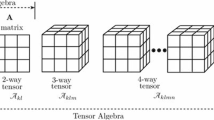Abstract
The paper presents a decision algorithmic model called vector gravitational force model in the feature space. The algorithmic model, inspired by and similar to the Law of Universal Gravitation, is derived from the vector geometric analysis of the linear classifier and established in the feature space. Based on this algorithmic model, we propose a classification method called vector gravitational recognition. The proposed method is applied to the benchmark Glass Identification task in the UCI Database available from USA Forensic Science Service, and other two UCI benchmark tasks. The experimental and comparative results show that the proposed approach yields quite good results and outperforms some well known and recent approaches on the tasks, and other applications may benefit from ours.


Similar content being viewed by others
References
Duda RO, Hart PE, Stork DG (2004) Pattern classification, 2nd edn. Wiley, New York. ISBN 0-471-05669-3
Theodoridis S, Koutroumbas K (2003) Pattern recognition, 2nd edn. Elsevier, Amsterdam. ISBN 0-12-685876-6
Haykin S (2001) Neural networks: a comprehensive foundation, 2nd edn. Prentice-Hall IncEnglewood Cliffs. ISBN 7-302-04936-X
Schreiber I, Ben-Bassat M (1990) Polygonal object recognition. Pattern Recognition, 1990. In: Proceedings, 10th international conference on 16–21 June 1990, vol 1,l pp 852–859
Chen SG, Wu JY (2005) A geometric interpretation of weighted normal vectors and its improvements. In: Computer graphics, imaging and vision: new trends, international conference on 26–29 July 2005, pp 422–425
Brandstein M, Ward D (eds) (2001) Microphone arrays. Springer, Heidelberg
Markou M, Singh S (2004) Feature selection based on a Black Hole model of data reorganization. In: 17th International conference on pattern recognition (ICPR04), Cambridge, pp 565–568
Singh S, Markou M (2005) A black hole novelty detector for video analysis. Pattern Anal Appl 8:102–114
Endo Y, Iwata H (2005) Dynamic clustering based on universal gravitation model. Lect Notes Comput Sci 3558:183–193
Wang C, Chen YQ (2005) Improving nearest neighbor classification with simulated gravitational collapse. Lect Notes Comput Sci 3612:845–854
Kita Y (1996) Force-based registration method using attribute values. In: Pattern recognition, proceedings of the 13th international conference on 25–29 Aug 1996, vol 2, pp 34–39
Cariou C, Chehdi K, Nagle A (2005) Gravitational transform for data clustering—application to multicomponent image classification. In: Acoustics, speech, and signal processing (ICASSP 2005), IEEE International Conference on March 18–23, 2005, vol 2, pp 105–108
UCI Machine Learning (2006) Machine-learning-databases. ftp://ftp.ics.uci.edu/pub/machine-learning-databases, 2006. (http://www.ics.uci.edu/∼mlearn/databases, 2006)
Spiehler V (1987) BEAGLE(Her rule-based system). DABFT Diagnostic Products Corporation
Xu Y, Zhang X (2005) Glass identification. http://www.stat.ohio-state.edu/∼goel//STATLEARN/PROJECTS/05Presentations/Xu_ZhangPresentation.pdf
Hechenbichler K, Schliep KP (2004) Weighted k-nearest-neighbor techniques and ordinal classification. Discussion Paper 399, SFB 386, Ludwig-Maximilians University Munich
Hechenbichler K (2005) Ensemble-Techniken und ordinale Klassifikation. PhD Thesis, Germany
Domeniconi C et al (2002) Locally adaptive metric nearest neighbor classification. IEEE Trans Pattern Anal Mach Intell 24(9):1281–1285
Gorzalczany MB, Gradzlu P (2000) A neuro-fuzzy-genetic classifier for technical applications. In: Proceedings of IEEE international conference on industrial technology 19–22, Jan. 2000, vol 2, pp 503–508
Tin J, Kwok Y (1999) Moderating the outputs of support vector machine classifiers. IEEE Trans NN 10(5):1018–1031
Tolson E (2001) Machine Learning in the area of image analysis and pattern recognition. Advanced Undergraduate Project, Spring
Loh W, Tim L, Shih YS (2000) A comparison of prediction accuracy, complexity, and training time of thirty-three old and new classification algorithms. Mach Learn 40(3):203–228
Copkun N, Yildirim T (2003) Image segmentation using statistical neural networks. In: International conference on artificial neural networks/international conference on neural information processing (ICANN/ICONIP), June 26–29, 2003, Istanbul, pp 154–156
Fisher RA (1936) The use of multiple measurements in taxonomic problems. Annu Eugen 7(II):179–188
Duda RO, Hart PE (1973) Pattern classification and scene analysis. Wiley, New York, pp 218. ISBN 0-471-22361-1
Dasarathy BV (1980) Nosing around the neighborhood: a new system structure and classification rule for recognition in partially exposed environments. IEEE Trans Pattern Anal Mach Intell 2(1):67–71
Gates GW (1972) The reduced nearest neighbor rule. IEEE Trans Inf Theory May 1972, pp 431–433
Duchene J, Leclercq S (1988) An optimal transformation for discriminant and principal component analysis. IEEE Trans Pattern Anal Mach Intell 10(6):978–983
Domeniconi C, Gunopulos D, Peng J (2005) Large margin nearest neighbor classifiers. IEEE Trans Neural Netw 16(4):899–909
Acknowledgments
The author would like to express thanks to the website of UCI Knowledge Discovery in Databases Archive & UCI Machine Learning and the authors for their efforts in publishing their data in the Internet, and Prof. Xu Ji-sheng for his beneficial discussions. The author would like to extend his thanks to the editor(s) and reviewer(s) for their helpful suggestions.
Author information
Authors and Affiliations
Corresponding author
Appendix A: A 2-D data simulation
Appendix A: A 2-D data simulation
The records used here for simulation are chosen from some Chinese students. Each instance has two numeric attributes (Height (cm) and Weight (kg)) and one of two possible categories (Sex): male or female. The training data has four instances including two boys and two girls (S i ,i = 1,2,3,4), and the test data has two instances including one boy (M*)and one girl(F*).
The simulation results based on the proposed Vector Gravitational Force are listed in Table 11 and demonstrated in Fig. 3.
From Table 11 and Fig. 3, we get and see: (M* → S 1) and (F* → S 4) by using the Vector Gravitational Force and both are correctly classified.
Rights and permissions
About this article
Cite this article
Zong-chang, Y. A vector gravitational force model for classification. Pattern Anal Applic 11, 169–177 (2008). https://doi.org/10.1007/s10044-007-0091-9
Received:
Revised:
Published:
Issue Date:
DOI: https://doi.org/10.1007/s10044-007-0091-9





